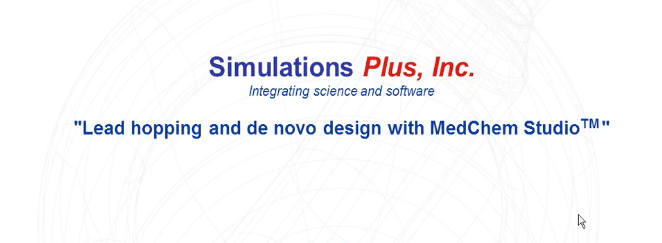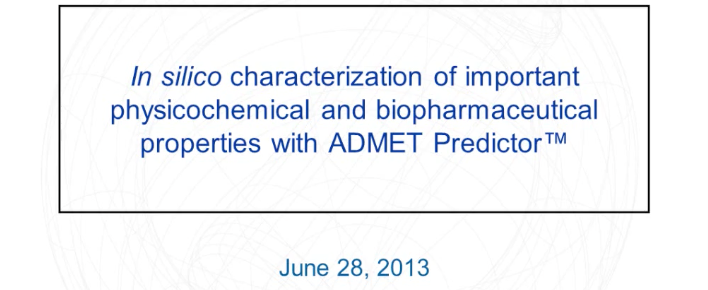Full-Year Revenue Up 6.6%; 6th Consecutive Profitable Year

Utility of Physiologically Based Modeling and Preclinical In Vitro/In Vivo Data to Mitigate Positive Food Effect in a BCS Class 2 Compound
Physiologically based pharmacokinetic (PBPK) modeling has become a useful tool to estimate the performance of orally administrated drugs.

Amorphous solid dispersions and nano-crystal technologies for poorly water-soluble drug delivery
Poor water-solubility is a common characteristic of drug candidates in pharmaceutical development pipelines today. Various processes have been developed to increase the solubility, dissolution rate...

Oral delivery of anticancer drugs: Challenges and opportunities
The present report focuses on the various aspects of oral delivery of anticancer drugs. The significance of oral delivery in cancer therapeutics has been highlighted which principally includes...

Lead hopping and de novo design webinar
This webinar discusses details of lead hopping and de novo design with MedChem Studio™, and demonstrates the software's ability to generate new virtual structures quickly and easily.

Simulations Plus Releases GastroPlus™ 8.5
Software Upgrade Adds Numerous Capabilities and User Convenience Features

In Vitro-In Vivo Correlation of Efavirenz Tablets Using GastroPlus®
The aim of the present work was to use GastroPlus™ software for the prediction of pharmacokinetic profiles and in vitro-in vivo correlation (IVIVC) as tools to optimize the development of new generic medications.

Physiologically Based Pharmacokinetic Modelling to Predict Single- and Multiple-Dose Human Pharmacokinetics of Bitopertin
This paper describes the use of physiologically based pharmacokinetic (PBPK) modelling and preclinical data to gain insights into and predict bitopertin clinical pharmacokinetics.

In Vitro Characterization of Axitinib Interactions with Human Efflux and Hepatic Uptake Transporters: Implications for Disposition and Drug Interactions
Axitinib is an inhibitor of tyrosine kinase vascular endothelin growth factor receptors 1, 2, and 3. The ATP-binding cassette (ABC) and solute carrier (SLC) transport properties of axitinib...

Investigation of clinical pharmacokinetic variability of an opioid antagonist through physiologically based absorption modeling
Identifying the source of inter- and/or intrasubject variability in pharmacokinetics (PK) provides fundamental information in understanding the pharmacokinetics-pharmacodynamics relationship...

Simulations Plus Completes Molecule Design Phase of Second NCE Project, Issues RFQs for Molecule Synthesis
Company Uses Proprietary Software Tools to Design New Molecules for COX-2 Inhibitors

Simulations Plus Completes Collaboration with Bayer HealthCare to Enhance Important Property Prediction in ADMET Predictor™
Prediction of Ionization Constants Key to Many Other Property Predictions

Simulations Plus Announces Quarterly Cash Dividend Increase
Board increases cash dividend again to $0.03 per share

Simulations Plus Releases MedChem Studio™ 3.5 and MedChem Designer™ 2.5
Software Upgrades Further Expand Powerful Data Mining and Molecule Design Programs, Extend Technological Lead of Simulations Plus

Simulations Plus Reports Third Quarter and First Nine Months FY2013 Financial Results
Third quarter net sales increase 11.7%; net income up 14.3%

Simulations Plus Sets Date for 3rd Quarter 2013 Earnings Release and Conference Call
Conference Call to be on Thursday, July 11, at 4:15 PM ET

Dendritic Cell Immunoreceptor Is a New Target for Anti-AIDS Drug Development: Identification of DCIR/HIV-1 Inhibitors
The HIV-1 pandemic continues to expand while no effective vaccine or cure is yet available. Existing therapies have managed to limit mortality and control viral proliferation, but are associated with side effects...

Similarity-based virtual screening for microtubule stabilizers reveals novel antimitotic scaffold
Microtubules are among the most studied and best characterized cancer targets identified to date. Many microtubule stabilizers have been introduced so far that work by disrupting the...

Low systemic testosterone levels induce androgen maintenance in benign rat prostate tissue
Prostate cancer (PC) is both an age- and an androgen-dependent disease. Paradoxically, systemic levels of androgens decline with age as the risk of PC rises. While there is no...

Physicochemical and biopharmaceutical properties
This webinar describes our modeling methodology and highlights the performance of key models. Special attention is devoted to our novel method of predicting macroscopic pKa, and our "Absorption Risk" Score.
